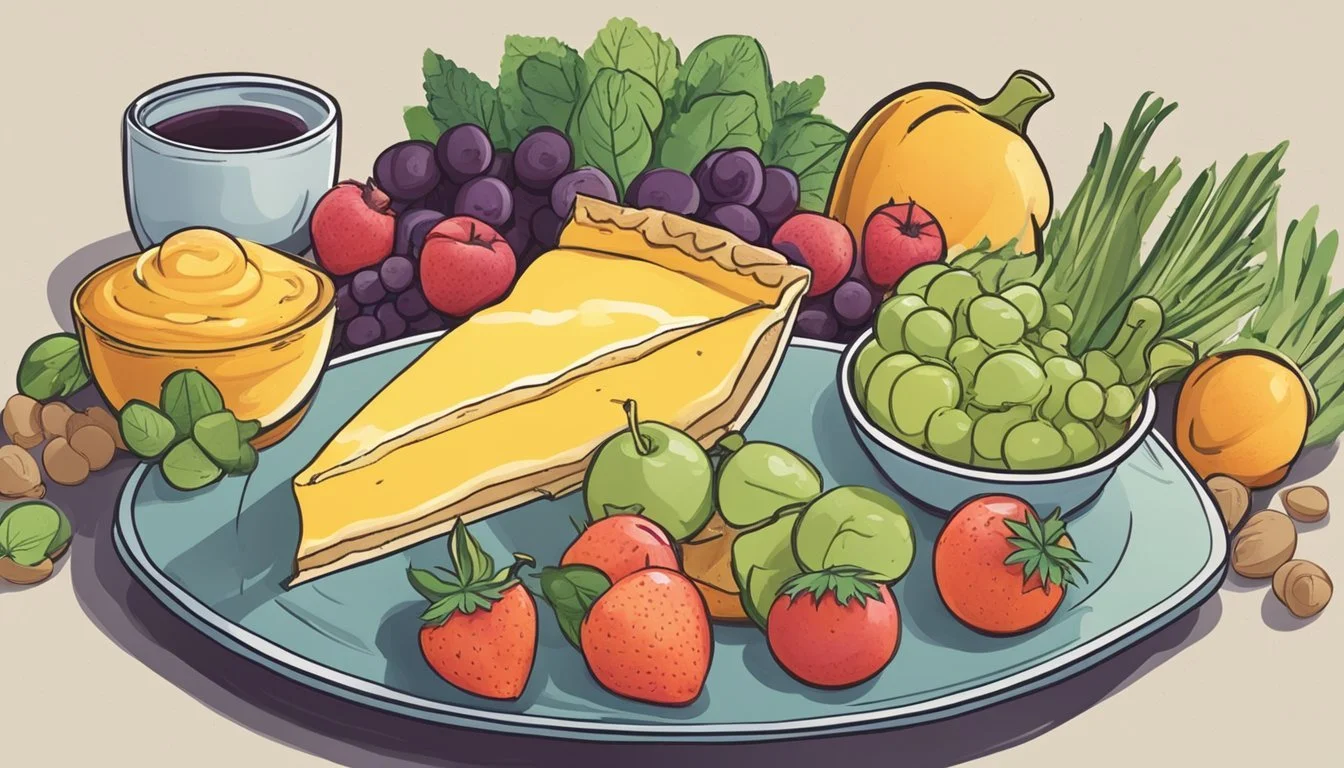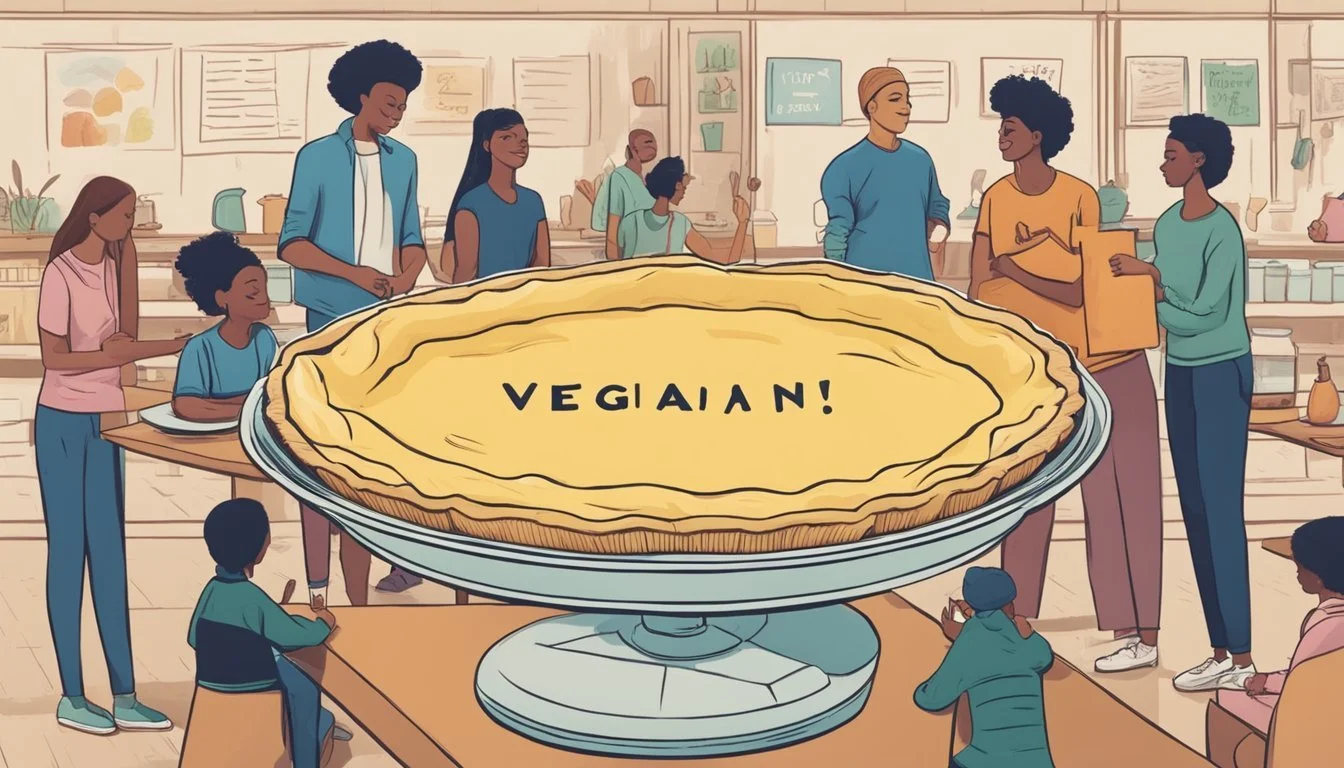Is Custard Pie Vegan?
Unveiling the Truth About This Classic Dessert
Custard pie, traditionally a baked dessert known for its creamy filling, is experiencing a culinary transformation as vegan diets gain popularity. A classic custard pie typically includes eggs, milk, and sugar, which are not vegan-friendly due to their animal origins. However, with the growing demand for plant-based alternatives, innovative adaptations of the traditional custard pie now cater to vegan dietary requirements.
In creating a vegan custard pie, common substitutions involve plant-based milks such as coconut or almond milk, and thickeners like cornstarch or agar agar to replace the eggs. Tofu is another versatile ingredient often used to achieve the pie's signature silky texture. When the right balance of these ingredients is achieved, the result is a dessert that aligns with vegan principles without compromising on the expected smooth and indulgent experience of a custard pie.
As the culinary world embraces inclusivity, vegan custard pies are becoming increasingly accessible and indistinguishable in quality and taste from their traditional counterparts. This evolution not only reflects the creativity of modern bakers but also offers a testament that vegan desserts can hold their own in the realm of pastries and sweets.
What Is Veganism?
Veganism is a lifestyle choice centered around the use of plant-based products and the exclusion of all animal products. Adherents to veganism follow a diet that consists solely of vegetables, fruits, legumes, nuts, seeds, and grains. Vegan individuals make conscious choices to avoid dairy, eggs, honey, and all other commodities derived from animals including non-food products.
The principles of veganism go beyond diet; it's an ethical stance against animal exploitation and cruelty. The avoidance of animal products extends to clothing, medicines, and other aspects of life.
The Distinction Between Vegan and Plant-Based Diets:
Vegan Diet: Involves abstaining from all animal products, aligning with the ethical principles of veganism.
No meat, poultry, fish, or insects.
No dairy products such as milk, cheese, or yogurt.
No other animal-derived substances like gelatin or certain food additives.
Plant-Based Diet: Primarily focuses on plants for food sources. While similar to veganism, it's not always synonymous. Some plant-based diets may include small amounts of animal products.
Considerations of Veganism:
Nutritional balance is key, ensuring adequate intake of proteins, vitamins, and minerals that are typically obtained from animal products.
Alternatives to dairy products in a vegan diet include:
Plant milks (almond, soy, rice, oat, etc.)
Vegan cheeses
Coconut yogurt and other plant-based fermented products
In essence, veganism is not just a diet; it is a lifestyle choice advocating for a sustainable and ethical relationship with the environment, where individuals refrain from contributing to animal harm in all possible aspects of their daily lives.
Understanding Vegan Custard
When exploring the option of vegan custard, it is vital to know that traditional custard components are replaced with plant-based alternatives without compromising on the creamy texture or rich flavor.
Key Ingredients in Vegan Custard
Vegan custard swaps out eggs and dairy milk for plant-based milks such as soy, almond, or coconut milk, and uses thickening agents like cornstarch. This eggless version still achieves the classic custard consistency.
Common Dairy Substitutes
Dairy milk is commonly replaced by coconut milk for its creamy texture, or by soy or almond milk for a lighter version. Each provides essential nutritional values such as calcium and vitamins while remaining animal-free.
The Role of Sweeteners
Sweetness is typically imparted using various sugars like granulated sugar, organic brown sugar, or cane sugar, all of which are plant-based and enhance the dessert’s sweet profile.
Flavor Enhancement
To mimic the depth of traditional custard, flavors like vanilla extract, cinnamon, nutmeg, or lemon are added. These not only boost taste but also contribute to the aroma.
Vegan Thickening Agents
Instead of eggs, vegan custard relies on thickening agents like cornstarch, tapioca, or agar-agar - a gelatinous substance popular in plant-based cooking for achieving the right texture.
Color and Aesthetics
For color, turmeric or saffron powder can impart a vibrant hue naturally, while keeping the custard visually appealing without artificial colorants.
Nutritional Considerations
Vegan custard offers an array of nutritional benefits, such as being lower in calories and cholesterol. It also has the potential for higher fiber content depending on the choice of thickeners and milk alternatives.
Recipe Adaptations
Vegan custard recipes are adaptable based on dietary preferences, including gluten-free options by selecting suitable thickening agents, or avoiding nuts for allergy considerations.
Potential Allergens
It's important to note key allergens in vegan custard such as soy, nuts, especially almonds, which are common in vegan recipes. Always check labels for hidden allergens if using store-bought alternatives.
Making the Perfect Vegan Pie
Crafting the perfect vegan pie involves a balance of a flaky crust, rich filling, and precise baking techniques. This endeavor requires attention to detail, from selecting the right ingredients to presenting the dessert in an appealing way.
Vegan Pie Crust Essentials
A vegan pie crust should be flaky, tender, and buttery without the use of animal products. Essential ingredients include a fat such as coconut oil or olive oil and a binding agent like almond meal. For a basic crust, mix 2 cups of flour with 1 teaspoon of salt, and cut in 3/4 cup of solidified fat, until the mixture resembles coarse crumbs. Add 4-6 tablespoons of ice water gradually, just enough to form a dough.
Creating a Balanced Filling
The filling of a vegan pie should be flavorful and creamy. Traditional custard can be made vegan by using coconut milk for its full-fat content, combined with a binding agent such as cornstarch or arrowroot powder. Sweeten to taste and add spices or fruit as desired. For a chocolate custard, mix in melted dairy-free chocolate.
Baking Techniques
Bake your vegan pie in a preheated oven to ensure even cooking. Vegan crusts and fillings generally bake well between 350°F and 400°F, with cook times varying based on the recipe. Always allow the pie to reach room temperature before serving to let the filling set.
Serving and Presentation
Serve vegan pies with dollops of vegan whipped cream or alongside fruit such as apple, orange, or grapes. Garnish your pie with powdered sugar or fruit reductions for an elegant touch.
Customizing Your Vegan Pie
Customize your pie with a variety of fruits, nuts, or chocolate. Vegan pies can range from the classic apple pie to a decadent chocolate custard pie. Infusing the filling with extracts or zest from fruits like orange can create a complex flavor profile.
Storage and Preservation Tips
To store, cover the pie loosely with foil and refrigerate for up to 5 days. Vegan pies can be frozen for longer storage. Wrap the pie tightly in plastic wrap and place it in a freezer-safe bag. Frozen pies can last for 1-2 months.
Dessert Pairings
Pair your vegan pie with complementary desserts like dairy-free cakes or ice cream. For a lighter option, serve with a fresh fruit tart.
The Perfect Finish
Top your pie with a light dusting of powdered sugar, a sprig of mint, or fresh fruit to add a visually appealing finish. Decorations should enhance the pie's appearance and hint at its flavors without overwhelming them.
Health and Nutrition
When considering vegan custard pie, it's important to look at the health and nutrition aspects. This dessert swaps out traditional ingredients for plant-based alternatives, which can offer a range of benefits.
Benefits of Vegan Desserts
Vegan desserts often have a lower content of saturated fats and cholesterol, as they omit dairy and eggs. This can be advantageous for heart health. They typically incorporate a variety of plant-based ingredients, which can contribute to a more diverse intake of nutrients.
Caloric and Macronutrient Profiles
The calorie content and macronutrients in a vegan custard pie can vary based on the ingredients used. For instance, a pie made with a tofu and coconut milk base may have higher protein and fat content than one made with almond milk.
Calories and Macronutrients for Common Non-Dairy Milk Bases:
Non-Dairy Milk Calories per 100g Protein (g) Carbohydrates (g) Fat (g) Coconut Milk 230 2.3 3.3 24 Almond Milk 17 0.6 0.6 1.5 Soy Milk 54 3.3 6.3 1.9 Oat Milk 50 1 9 1.5
Vitamins and Minerals Content
Plant-based ingredients can enrich a vegan custard pie with essential vitamins and minerals. Ingredients such as coconut milk may provide iron, potassium, and certain B-vitamins. Enriched non-dairy milks can also be a source of vitamin D and calcium.
Non-Dairy Milk Benefits
Non-dairy milks such as soy, almond, and oat milk often come fortified with vitamins and minerals. They also tend to be lower in calories and fat compared to traditional cow's milk, and can be rich in heart-healthy unsaturated fats.
Identifying Healthy Fats
Vegan custard pies can contain healthy fats from ingredients like coconut oil, which contains medium-chain triglycerides (MCTs). Unsaturated fats, such as those found in nuts and seeds used in pie crusts, can support cardiovascular health.
Reducing Added Sugars
When making vegan custard pie, opting for natural sweeteners or reduced quantities of sugar can lower the overall caloric intake. Sweeteners like organic granulated sugar or cane sugar can be used sparingly.
Fiber-Rich Ingredients
Utilizing ingredients like nuts, seeds, or whole-grain flours in the crust of vegan custard pies can boost the fiber content, promoting healthy digestion. The inclusion of fruit toppings adds not only flavor but also additional nutritional value through fiber and vitamins.
Social and Ethical Considerations
When considering the vegan status of custard pie, one must evaluate the social and ethical implications of its ingredients and production. This scrutiny commonly involves the welfare of animals, the environmental impact of dairy production, the influence of social media, and the role veganism plays within the community.
Animal Welfare and Veganism
The vegan community advocates for animal rights and the elimination of animal products due to ethical concerns regarding the treatment of animals. Traditional custard pie is not vegan as it typically contains eggs and milk from animals, which clashes with the ethical choice to prevent animal exploitation.
Environmental Impact of Dairy
Dairy production has a significant environmental footprint, with concerns arising from greenhouse gas emissions, land and water usage, and pollution. A plant-based version of custard pie lessens this impact, aligning with the environmental goals of veganism.
Social Media and Veganism
Platforms like Instagram, Facebook, and Pinterest have become pivotal for vegan influencers to educate and share information about vegan lifestyles. These spaces aid in increasing the social acceptance of veganism and often serve as support groups for the vegan community.
Veganism and Community
Local and online support groups foster a sense of community and provide resources for individuals seeking to make ethical choices in their diet. Vegan communities on social platforms form networks that promote plant-based living, often shaping the public's perception of veganism and contributing to its growing acceptance.
Vegan Baking FAQs
When diving into vegan baking, one may have numerous queries regarding substitutes for traditional ingredients and techniques for ensuring satisfactory results. This section addresses some of the most frequently asked questions and provides practical advice to help both new and experienced vegan bakers.
Common Vegan Baking Substitutes
Vegan baking often requires substitutes for commonly used animal-based ingredients. Here are some of the standard replacements:
Milk: Plant-based milks such as almond, soy, and oat milk can be used at a 1:1 ratio.
Butter: Vegan butter or oils like coconut or canola are effective alternatives.
Eggs:
For binding: Mashed bananas or apple sauce can be used, with generally 1/4 cup per egg.
For leavening: Combine 1 tablespoon of vinegar with 1 teaspoon of baking soda to replace 1 egg.
For moisture: Silken tofu or yogurt alternatives work well.
Tips for First-Time Vegan Bakers
Embarking on vegan baking can seem daunting at first. Here are some tips for beginners:
Read recipes thoroughly before starting. Preparation is key in baking.
Invest in a kitchen scale. Accurate measurements are critical for consistent results.
Be familiar with substitutions, but also expect slight differences in taste and texture.
Overcoming Baking Challenges
Vegan bakers may face unique challenges with texture and consistency. To address these issues:
Experiment with flour types. Gluten-free options like almond or oat flour may require different ratios.
Understand the role of each ingredient. For example, xanthan gum can help with elasticity in gluten-free recipes.
Practice makes perfect. Consistency comes from trial and error, so don't be discouraged by initial setbacks.
By familiarizing oneself with vegan substitutes, adhering to precise measurements, and not shying away from experimentation, bakers can enjoy a wide range of delicious vegan treats.
Conclusion
Traditionally, custard pie is not vegan as it often includes eggs and dairy milk in its filling. However, the culinary world has evolved to make room for vegan versions of beloved desserts, including custard pie. By replacing animal-derived ingredients with plant-based alternatives, such as tofu, coconut milk, and non-dairy milk, chefs and home cooks alike can create delicious vegan custard pies that cater to dietary preferences and ethical choices.
Key Components of Vegan Custard Pies:
Base: Tofu or agar can serve as the foundation, providing the creamy texture associated with custard.
Milk: Coconut milk or other non-dairy milk varieties replace dairy milk to maintain the richness.
Sweeteners: Sugar or natural sweeteners add the necessary sweetness without using animal products.
Thickeners: Cornstarch or custard powder help in achieving the pie's firmness.
In the context of vegan desserts, custard pie holds its place on the menu with grace, proving that traditional flavors can be enjoyed without compromising vegan values. These pies can compete with their non-vegan counterparts in taste and texture, making them a delectable option for any occasion.
In summary, vegan custard pie represents a conscious choice for individuals following a plant-based diet, and its creation shows the adaptability of traditional recipes to fit modern dietary needs. The culinary innovation ensures that vegan custard pie stands tall among dessert options, pleasing palates while aligning with ethical and dietary requirements.






